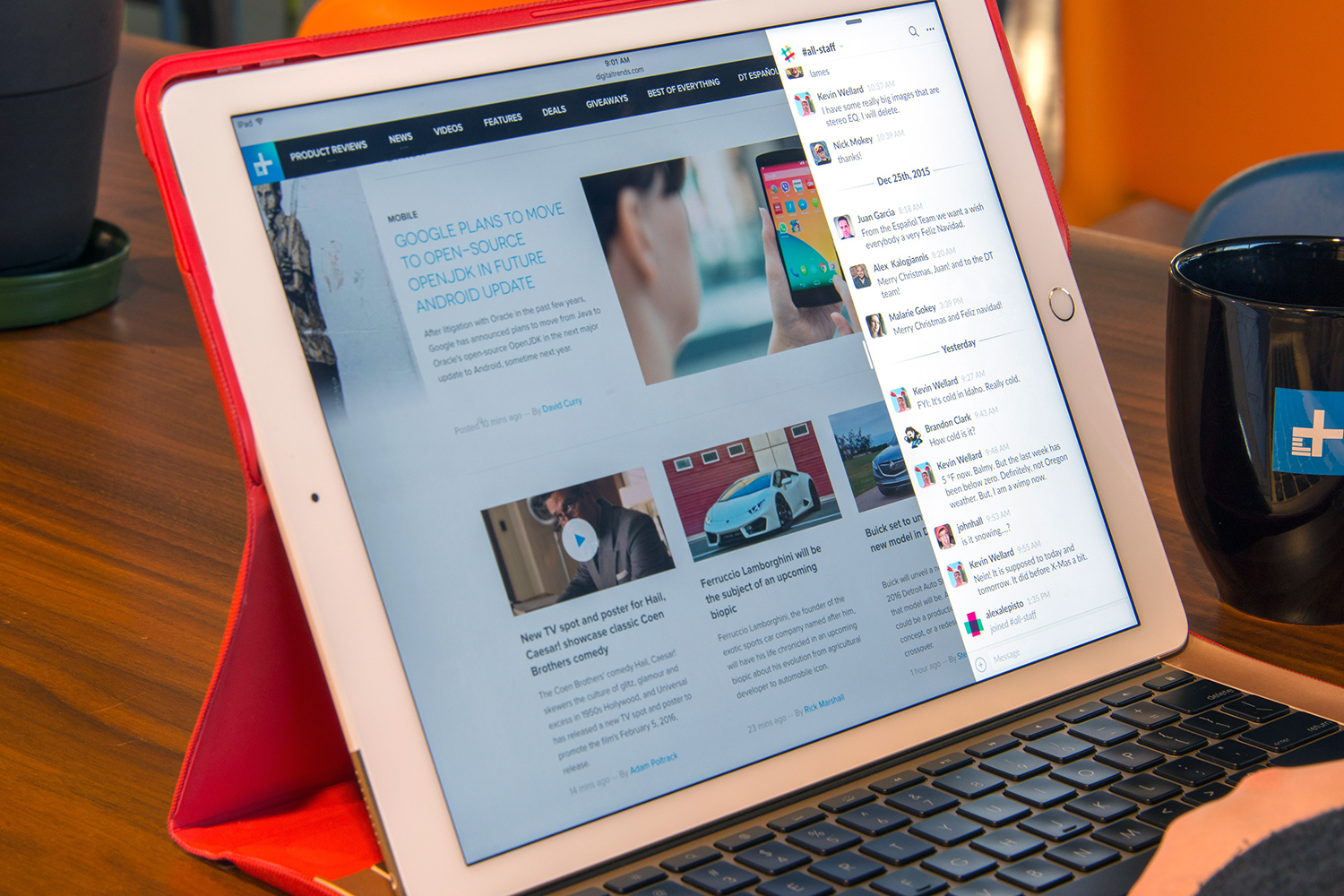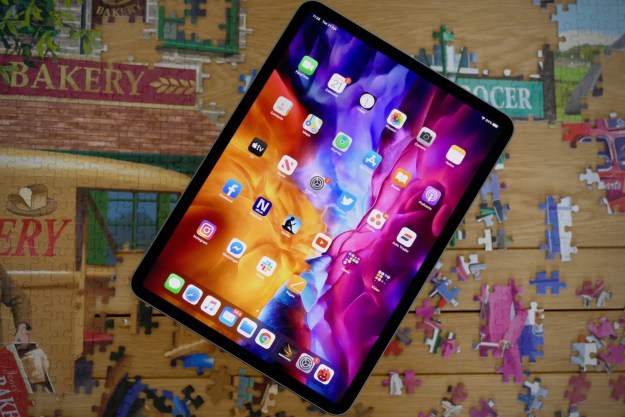This giant tablet isn’t just a potential laptop replacement: It’s also a close competitor for the iPad Pro. They look similar, they’re sized similarly, and they’re even exactly the same thickness. But which is the better buy? Here’s a by-the-numbers rundown.
| iPad Pro | Huawei Matebook | |
| Dimensions | 12 × 8.68 × 0.27 (in) | 10.98 × 7.64 × 0.27 (in) |
| Weight | 1.57 pounds | 1.41 pounds |
| Keyboard | Available for $169 | Available for $130 |
| Processor | Apple A9X 2.26 GHz | 6th Gen Intel Core M 3.1GHz |
| RAM | 4G LPDDR4 | 4GB or 8GB LPDDR3 |
| Display | 12.9-inch Retina display | 12-inch IPS LCD |
| Resolution | 2,732 × 2,048 pixels | 2,160 × 1,440 pixels |
| Storage | 32GB or 128GB | 128GB, 256GB, or 512GB |
| Networking | Wi-Fi, 4G LTE, HSPA+, Bluetooth 4.2 | Wi-Fi, Bluetooth 4.1 |
| Ports | Headphone, Lightning | Headphone, USB 3.1 Type C, Keyboard smart cover connector. |
| Camera | 8MP rear facing, 1.2 MP front facing | 5MP front facing |
| Operating System | iOS 9 | Windows 10 |
| Battery | 10 hours | 10 hours |
| Price | Starts at $799 | Starts at $700 |
| Availability | Available now | Available in “coming months” |
| Review | 4.5 out of 5 | Review coming soon; Hands-on impressions here |
Design
We haven’t spend a lot of time with the Huawei Matebook yet, so we can’t provide a lot of detail on things like build quality. But it’s hard to deny that the Huawei Matebook closely resembles the iPad Pro, and in many ways it gives Apple’s famous design a run for its money.
Both tablets are 0.27 inches thick, for example. The Huawei is lighter than the iPad Pro, at 1.41 pounds, but mostly because the iPad Pro is bigger: It’s 12 inches wide, where the Matebook is closer to 11, and 8.68 inches wide to the Matebook’s 7.64 inches.
Both devices offer optional keyboards, the Matebook with a touchpad and the iPad Pro without. Both offer an optional stylus.
The iPad Pro has a rear-facing camera and a front-facing camera, while the Matebook has only the front-facing camera.
Winner: Tie. The iPad Pro is the bigger of the two tablets, but there’s a lot to like about the Matebook’s design as well.
Display
This contest is a little more clear cut. Apple offers the bigger of the two displays, at 12.9 inches to Huawei’s 12. It also offers by far the higher resolution: the iPad Pro’s display is 2,732 x 2,048 pixels, significantly higher than Huawei’s 2,160 x 1,440 pixels.
In pixels per inch, the iPad Pro’s 264 handily beats the Matebook’s 216. Apple is famous for their display quality, and Huawei doesn’t beat them on that front here.
Winner: iPad Pro
Performance
The Matebook sports 3.1GHz Intel Core M processor, giving it more power on paper than the Apple A9X 2.26GHz included in the iPad Pro. Directly comparing these processors beyond that is tricky because of their different contexts — the Matebook is running the desktop version of Windows, while the iPad Pro is running a mobile OS.
Given that these two systems are running such vastly different opearting systems, it’s difficult to directly compare how these numbers will affect experience. But in terms of raw numbers, Huawei comes out ahead.
The iPad Pro comes with 4GB of LPDDR4 meory, while the Matebook comes with 4GB of slightly slower LPDDR3. Unlike with the iPad Pro, the Matebook offers an 8GB memory update.
But perhaps the biggest advantage the Matebook offers is internal memory. The iPad Pro comes with an embarrassingly low 32GB of internal memory, or you can opt for a 128GB upgrade. The Huawei Matebook starts at 128GB, and also offers 256GB and 512GB options at higher price points.
Winner: Huawei Matebook
Features
It’s hard to remember now, but back when the Apple tablet was just a rumor the tech press wasn’t sure whether the hypothetical device would run the iPhone operating system or Mac OS X. Apple, of course, choose iOS, and most tablets have been built on mobile operating systems ever since. The iPad Pro is Apple stretching iOS to its limit, and while the device got rave reviews the lack of real multi-tasking on such a big screen was a real concern. Should a device that big and powerful still be running a mobile operating system?
When we tried replacing a laptop with an iPad Pro, our results were mixed. The Matebook won’t have the same problems, because for all practical purposes it is a laptop. Anything you can do with Windows, you can do on this device, including running the full versions of Microsoft Office and Adobe’s Creative Suite.

You could argue there are downsides to this. You won’t have access to the iOS App Store, and Microsoft’s tablet-oriented Windows Store is mediocre at best. But a display this big just begs for true multitasking, and Windows 10 delivers that.
There’s also a dock for the Matebook that provides a number of extra ports: two USB ports, Ethernet, VGA, HDMI, and even a USB Type-C port for change. It’s not clear whether this device will come with the tablet, or be available as a separate purchase, but it’s going to make the Matebook very versatile, and the iPad Pro doesn’t offer anything like it.
Winner: Huawei Matebook
Conclusion
In some ways these are very different devices, but it’s hard to recommend the iPad Pro over the Huawei Matebook, at least based on a for-the-numbers comparison. It offers higher specs, a full desktop operating system, and similar design appeal. All that at a lower starting price-point than Apple’s offering.
The only clear win for the iPad Pro is the display, which is excellent as is usual for Apple.
Editors' Recommendations
- Apple accidentally revealed a big iPad Pro display upgrade
- You may have to wait a while longer for new iPads
- I’m worried about Apple’s new iPads
- Could the Vision Pro replace your iPad? There’s just one problem
- Apple’s new iPad Pro may not be as expensive as we feared




